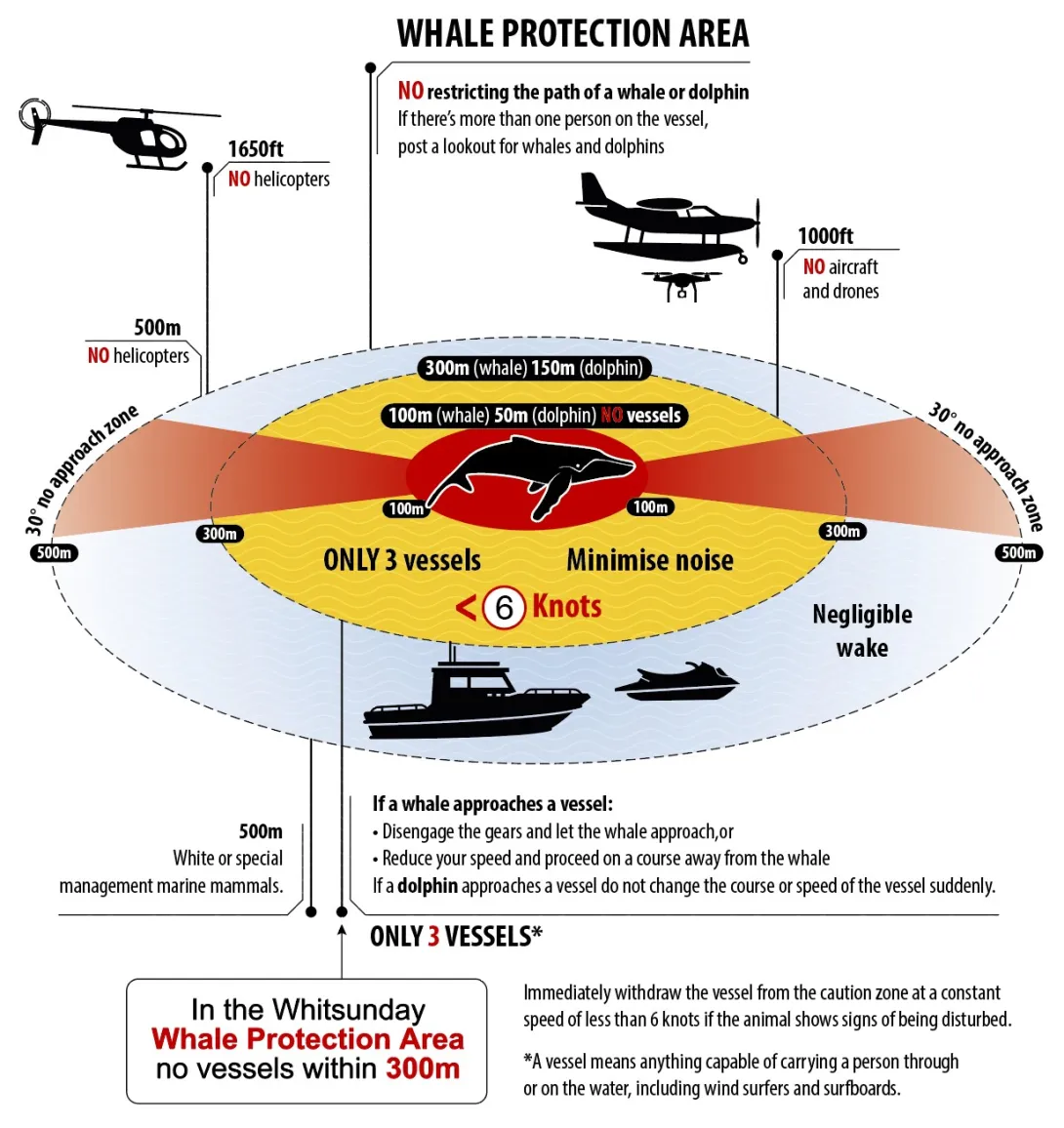The Great Barrier Reef is a vitally important breeding ground for about 30 species of whales and dolphins (cetaceans).
The most commonly sighted whales are humpbacks, which migrate from Antarctica to the warmer waters of the Great Barrier Reef Marine Park each year from May to September - to court, mate, give birth or rear their calves.
We all have a responsibility to help protect whales and dolphins and to keep safe distances from them.
- Have you seen any whales?
- Log your sightings on the Eye on the Reef App
Operating a vessel or aircraft
- When operating a vessel or aircraft:
- Boats must stay at least 100 metres from whales in the Great Barrier Reef Marine Park.
- Boats must always stay 300 metres from a whale calf.
- Jet skis must stay 300 metres away from whales.
- Approach the whale or dolphin only from the rear or by positioning the vessel ahead of the whale or dolphin, and always in a position that is more than 30 degrees to its observed direction of travel
- If the whale or dolphin is a calf, a vessel must not enter within a radius of 300 metres of the whale and 150 metres of the dolphin (i.e. the caution zone)
- If a calf appears, causing your vessel to be within the caution zone, you must stop the vessel and turn off the engines or disengage the gears or withdraw your vessel at a constant slow speed
- If your vessel is closer than 300 metres to a whale or 150 metres to a dolphin, it must be operated at a constant slow speed; if closer than 50 metres to a dolphin, the vessel must not change course or speed suddenly
- If there are three vessels within 300 metres of a whale or dolphin, all additional vessels must remain outside a 300 metres radius of the whale or dolphin
- If a whale approaches close to your vessel, take all precautions to avoid a collision; either slow down and steer away from the animal or place the engines in neutral and let the animal pass
- If you accidentally strike a whale or dolphin you must report it. To report sick, injured, stranded or dead marine animals contact the Queensland Department of Environment, Tourism, Science and Innovation (DETSI) using the free QWildlife app for iOS and Android, or call 1300 130 372 (press option 1).
Aircraft, Prohibited vessels and Helicopters
- Additional whale distancing rules apply to the above:
- Prohibited vessels (i.e. jet skis, parasails, hovercraft, hydrofoils, wing-in-ground effect craft and motorised diving aids such as underwater scooters) must not approach closer than 300 metres to a whale or dolphin
- An aircraft (including drones) must not operate below 1000 feet within a horizontal radius of 300 metres of a whale or dolphin and must not approach a whale or dolphin head on
- In addition, a helicopter must not operate below 1650 feet within a horizontal radius 500 metres of a whale or dolphin
Are you in the Whitsundays? Additional rules apply
- There are additional rules in relation to whales within the Whale Protection Area which covers most of the Whitsundays Planning Area. In the Whale Protection Area:
- Boats must stay at least 300 metres from whales.
- A helicopter must not approach below 2000 feet or within 1000 metres of a whale within the Whitsundays Planning Area
- Whale watching as part of a tourist program is prohibited
Map of the Whale Protection area is available on page 10 of A guide to tourism operations and other commercial activities in the Whitsundays - Great Barrier Reef Marine Parks and Island National Parks.

Legal Requirements
- When you encounter whales or dolphins, either from a vessel, aircraft or in the water:
- You must not kill, take, injure and/or interfere with whales and dolphins - interference includes harassing, chasing and herding
- You must not restrict the path of whales or dolphins
- You must not touch or feed, or attempt to touch or feed, a whale or dolphin
- You must not enter the water within 100 metres of a whale or within 50 metres of a dolphin
- You must not approach closer than 30 metres to a whale or dolphin if you are in the water. If a whale or dolphin approaches you while you are in the water, move slowly, do not touch or swim towards it
- You must minimise noise when closer than 300 metres from a whale or dolphin.
- The following legal requirements are set out in the Great Barrier Reef Marine Park Regulations 2019 and are complemented under the Environment Protection and Biodiversity Conservation Act 1999.
Commercial dugong watching
Australia has international, national, and state obligations to conserve dugongs.
Dugongs are listed as vulnerable to extinction at a global scale by the International Union for the Conservation of Nature's Red List Categories (IUCN 2003).
In Australia, dugongs are protected under the Environment Protection and Biodiversity Conservation Act 1999 as a listed migratory species and a listed marine species and as being ‘vulnerable’ under schedule three of Queensland’s Nature Conservation (Wildlife) Regulation 2020.
Dugongs are also listed as a protected species in the Great Barrier Reef Marine Park under the Great Barrier Reef Marine Park Regulations 2019.
Commercial dugong watching involves tourist vessel operations, specifically targeting areas where dugongs are commonly found in order to show these animals to paying passengers.
If you are interested in commercial dugong watching, you will require a permit. Please contact us for further information by emailing assessments@gbrmpa.gov.au.
